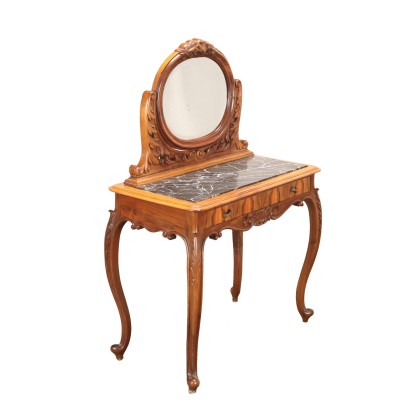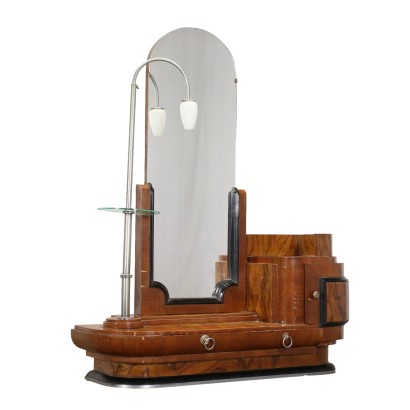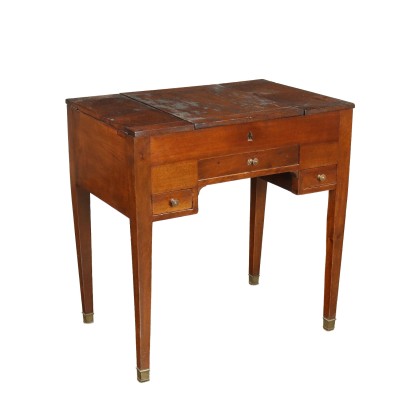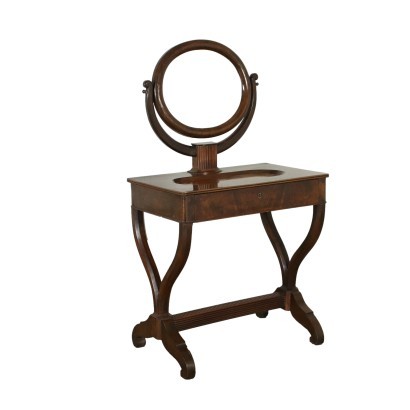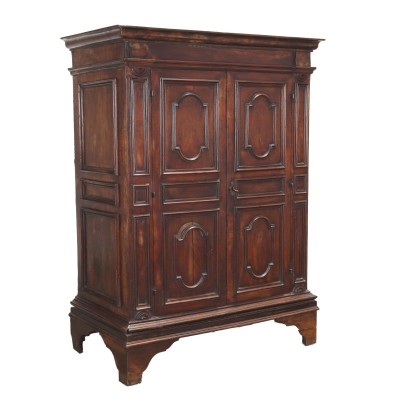Chippendale Style Dressing Table Walnut Italy XX Century - Italy Early 20th century
Features
Style: In the style of Chippendale
Age: 20th Century / 1901 - 2000
Origin: Italy
Main essence: Mahogany , Walnut
Material: Walnut Veneer , Carved Wood , Marble , Mirror
Description
Chippendale style dressing table in solid walnut veneered walnut, Italy early 20th century. Raised carved with leaf elements and equipped with tilting ground mirror, marble top, drawer in the band, wavy legs. Mahogany interior.
Product Condition:
Product that due to age and wear requires restoration and resumption of polishing.
Dimensions (cm):
Height: 133,5
Width: 89
Depth: 48
Additional Information
Style: In the style of Chippendale
Predominant style in English furniture in the second half of the eighteenth century.
The Chippendale style is named after Thomas Chippendale, a famous English furniture manufacturer of the 1700s.
He began by designing Rococo-style furniture with the addition, from time to time, of oriental decorations and finally furniture with a neoclassical taste.
Its production concerns decidedly expensive and elaborate furniture but also common and, above all, cheap ones.
This style is, chronologically, followed by Art-Decò and Liberty.
Age: 20th Century / 1901 - 2000
20th Century / 1901 - 2000 Main essence:
Mahogany
It is one of the most precious and sought-after woods in cabinet making. It was discovered in Central America around 1600 and began to be imported to England in the 1700s. Much appreciated for its hardness and indestructibility, it became widespread following the blocking of walnut exports from France in 1720 and the consequent elimination of English import duties on mahogany from the colonies in America and India. The most valuable version comes from Cuba, but it became very expensive. At the end of the 18th century it began to be used also in France in Louis XVI, Directory and Empire furniture, its diffusion declined starting from when Napoleon, in 1810, forbade its import. It was generally used in the manufacture of elegant furniture, due to its characteristics and beautiful grain.
Walnut
Walnut wood comes from the plant whose botanical name is juglans regia , probably originally from the East but very common in Europe. Light or dark brown in color, it is a hard wood with a beautiful grain, widely used in antique furniture. It was the main essence in Italy throughout the Renaissance and later had a good diffusion in Europe, especially in England, until the advent of mahogany. It was used for solid wood furniture and sometimes carvings and inlays, its only big limitation is that it suffers a lot from woodworm. In France it was widely used more than anything else in the provinces. In the second half of the eighteenth century its use decreased significantly because mahogany and other exotic woods were preferred. Material:
Walnut Veneer
Carved Wood
Marble
Mirror



